To optimize your engine’s performance, you need to examine your spark plugs carefully. Check the color and deposits—light tan or gray indicates good combustion, while black soot or white insulators suggest issues like a rich fuel mix or overheating. Watch for uneven wear or damage, which can signal underlying problems. Regularly inspecting and cleaning your spark plugs helps improve efficiency and avoid serious problems. Keep reading to discover how interpreting these signs can boost your vehicle’s performance.
Key Takeaways
- Examine spark plug color; light tan or gray indicates proper combustion, while black soot suggests rich fuel mixture issues.
- Check electrode wear; even, minimal erosion signifies healthy ignition performance, whereas excessive wear indicates tuning needs.
- Identify deposits; oily or carbon buildup can point to oil leaks or incomplete combustion affecting tuning adjustments.
- Assess insulator condition; white or blistered insulators signal overheating, requiring timing or mixture corrections.
- Use deposit patterns and wear to diagnose engine issues, enabling precise adjustments for optimal performance tuning.
Understanding the Basics of Spark Plugs
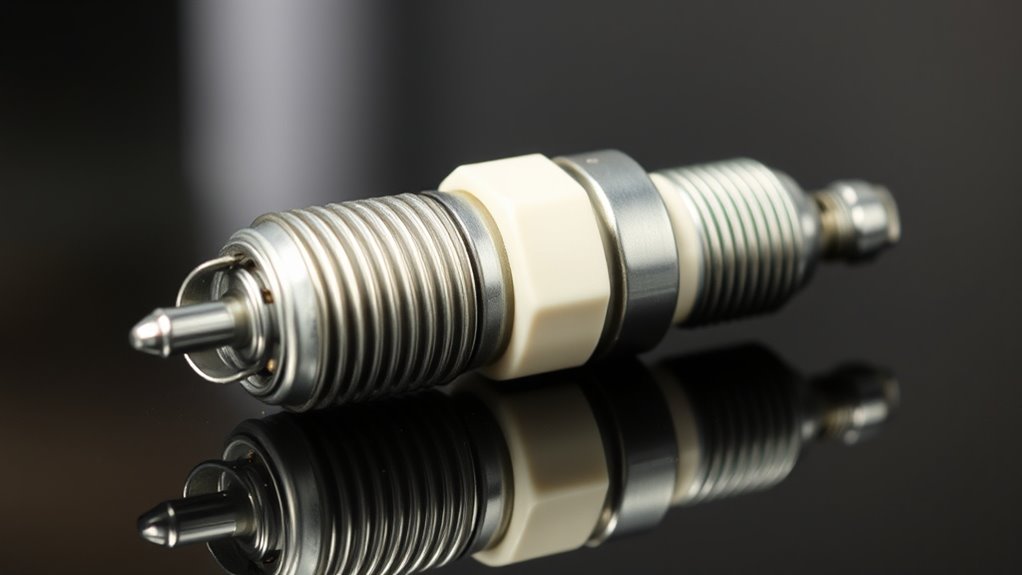
Spark plugs are essential components that ignite the fuel-air mixture in your engine’s cylinders, enabling your vehicle to run smoothly. They consist of a metal shell, insulator, and central electrode, with a gap between the center and ground electrode. When the ignition system sends a high-voltage current, the spark jumps across this gap, igniting the mixture. Spark plugs are designed to withstand extreme heat and pressure while providing a reliable spark. Different types, such as copper, platinum, and iridium, offer varying durability and performance. Understanding these basics helps you grasp how your engine fires and why proper spark plug maintenance is vital. Knowing the purpose and function of spark plugs lays the foundation for more advanced tuning and troubleshooting.
Signs of Proper Spark Plug Functioning

When your spark plugs are working properly, you’ll notice a consistent, light-colored spark on the insulator tip. Additionally, the electrodes should show even wear, indicating balanced operation over time. These signs help make sure your engine runs smoothly and efficiently. Regular inspection of spark plugs can also help identify issues that may be caused by engine tuning or other modifications.
Consistent Spark Color
Maintaining a consistent spark color is a clear indicator that your spark plug is functioning properly. When your spark’s hue stays steady over time, it shows the combustion process remains balanced. A normal spark appears light tan or gray, signaling good fuel mixture and combustion. If the color shifts unexpectedly, it could mean issues like rich or lean mixtures, which affect performance. To help you interpret spark colors, here’s a quick guide:
| Spark Color | Meaning | Action Needed |
|---|---|---|
| Light Tan/Gray | Healthy combustion | No action needed |
| Dark Brown/Black | Too rich or oil fouling | Check fuel/air mixture |
| White/Light Gray | Lean mixture | Adjust fuel supply |
| Oily or Wet | Fouling or oil leak | Inspect engine and plugs |
Consistent spark color also indicates proper combustion balance, essential for optimal engine performance and efficiency.
Even Electrode Wear
Even electrode wear is a key indicator that your spark plug is functioning properly. When the electrodes wear evenly, it shows your ignition system is balanced and firing consistently. You’ll notice the center and ground electrodes maintaining a uniform shape and size, with no signs of excessive erosion or uneven rounding. This steady wear indicates the plug is operating under normal conditions, not experiencing detonation or misfires. If the wear is even, your engine’s performance remains smooth, fuel efficiency stays ideal, and spark strength stays consistent. Regularly checking for even electrode wear helps you identify when the plugs are nearing the end of their lifespan or if adjustments are needed. Color accuracy in the electrodes can also affect performance, as inconsistent coloration may hint at underlying issues. Keeping tabs on electrode wear ensures your engine runs reliably and at peak performance.
Identifying Abnormal Wear Patterns
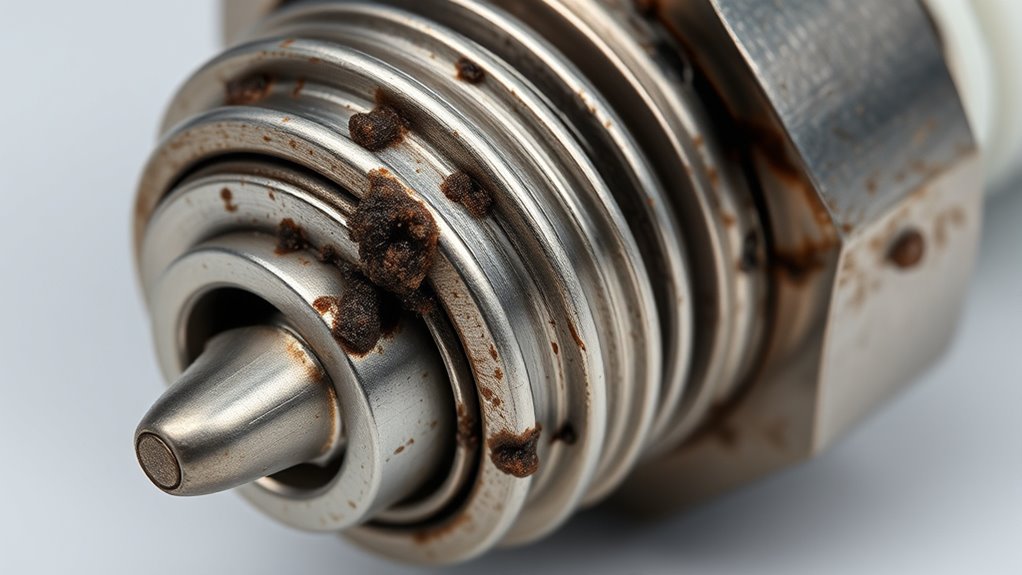
Identifying abnormal wear patterns on spark plugs is crucial for diagnosing engine issues early. If you notice uneven or unusual wear, it can signal underlying problems such as fuel mixture issues, overheating, or mechanical faults. Common abnormal patterns include a rough, chipped, or melted electrode, indicating excessive heat or detonation. You might also see a buildup of ash or oil deposits, pointing to oil leaks or rich fuel mixtures. Additionally, irregular electrode erosion or the presence of cracks suggests physical damage or pre-ignition. Be attentive to these signs, as they can help you pinpoint specific engine troubles before they worsen. Regular inspection of wear patterns allows you to catch problems early and maintain prime engine performance. For example, understanding the horsepower of your engine can help determine if your spark plug is operating within optimal conditions.
Analyzing Spark Plug Coloration and Deposits
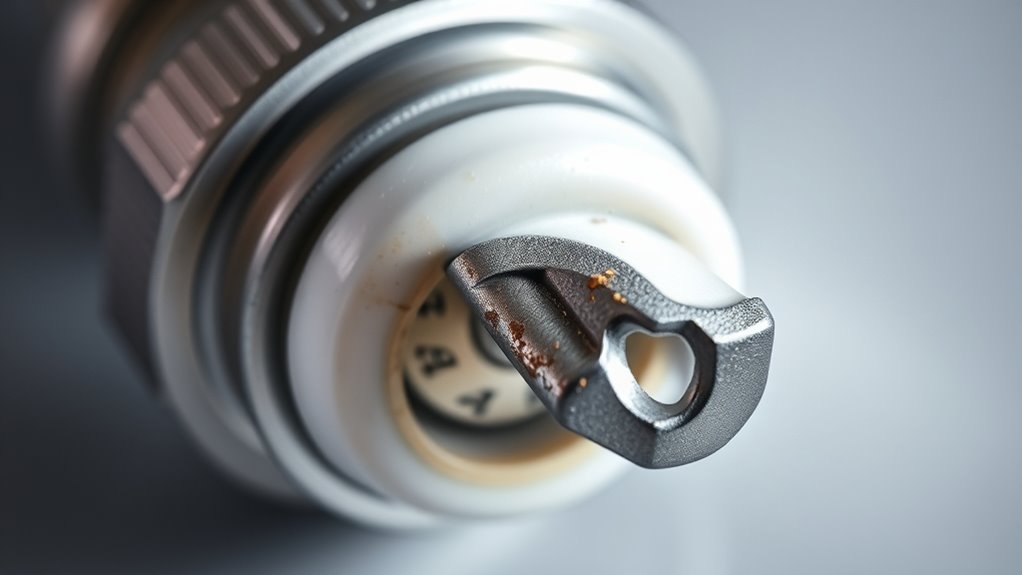
Examining the coloration and deposits on your spark plugs offers valuable insights into your engine’s health. The color reveals how well your engine runs and if adjustments are needed. A light tan or grayish hue indicates proper combustion and ideal performance. Black, sooty deposits suggest rich fuel mixtures or oil burning, while white or blistered insulators point to overheating. Use this table to identify common deposit types:
| Color/Deposit | Meaning | Action Needed |
|---|---|---|
| Light tan/gray | Normal combustion | No change needed |
| Black/sooty | Rich mixture or oil fouling | Adjust fuel or check oil control |
| White/blistered | Overheating or pre-ignition | Check cooling and timing |
Regular inspection helps maintain peak performance and prevent engine issues. Additionally, understanding the deposits on spark plugs can help tailor your maintenance routine for better efficiency.
Interpreting Spark Plug Condition for Fuel Mixture Tuning

Interpreting the condition of your spark plugs is essential for tuning your fuel mixture effectively. When inspecting your plugs, look beyond color and deposits to understand how the mixture influences combustion. A clean, tan insulator indicates a proper air-fuel ratio, while black soot suggests a rich mixture. White or blistered electrodes point to a lean mix, risking misfire or overheating. Conversely, wet or oily deposits may signal oil leaks or overly rich conditions. To fine-tune your fuel mixture, consider these factors:
- Consistent coloration across all plugs signals balanced tuning.
- Deposits or discoloration patterns pointing to specific fueling issues.
- Wear or damage indicating ignition or mixture problems affecting combustion quality.
Interpreting these signs helps you optimize engine performance and prevent potential damage.
Recognizing Signs of Combustion Efficiency Issues
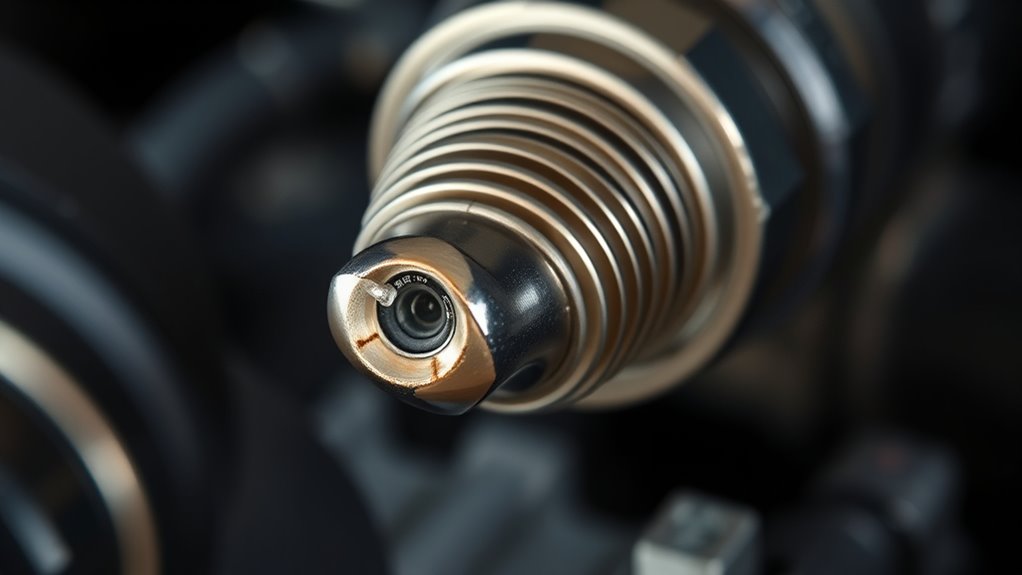
You might notice uneven spark plug wear or black carbon deposits, which can signal combustion problems. These signs often point to issues like improper fuel mixture or incomplete combustion. Recognizing them early helps you keep your engine running smoothly and efficiently. Monitoring air quality indicators can also help detect underlying engine issues affecting combustion performance.
Uneven Spark Plug Wear
Uneven spark plug wear is a clear sign that your engine may be struggling with combustion efficiency issues. When you notice irregularities across your spark plugs, it indicates inconsistent combustion within cylinders. This can lead to power loss, reduced fuel economy, and increased emissions. To diagnose, check for:
- One plug notably more worn or fouled than others
- Variations in electrode wear patterns across plugs
- Distinct differences in color or deposits on individual plugs
Uneven wear often points to problems like misfiring, faulty ignition components, or uneven fuel distribution. Recognizing these signs early can prevent further engine damage and optimize performance. Regular inspection of spark plugs helps you catch these issues before they escalate, ensuring your engine runs smoothly and efficiently. Addressing underlying causes such as ignition system issues can help prevent uneven wear from recurring.
Black Carbon Deposits
Have you noticed black, sooty deposits on your spark plugs? These deposits indicate incomplete combustion, often caused by rich fuel mixtures, oil leaks, or carbon buildup. When your plugs are coated in black carbon, it suggests your engine isn’t burning fuel efficiently. This imbalance can be linked to issues with combustion efficiency that affect overall engine performance. Check the spark plug’s insulator and electrodes for a thick, oily or sooty layer. If you see these signs, it’s time to adjust your air-fuel mixture, inspect for oil leaks, or perform a thorough cleaning. Addressing black carbon deposits promptly helps improve combustion efficiency, engine performance, and longevity. Regular spark plug inspection is essential for maintaining optimal engine health and catching issues early.
Using Spark Plug Data to Diagnose Engine Problems
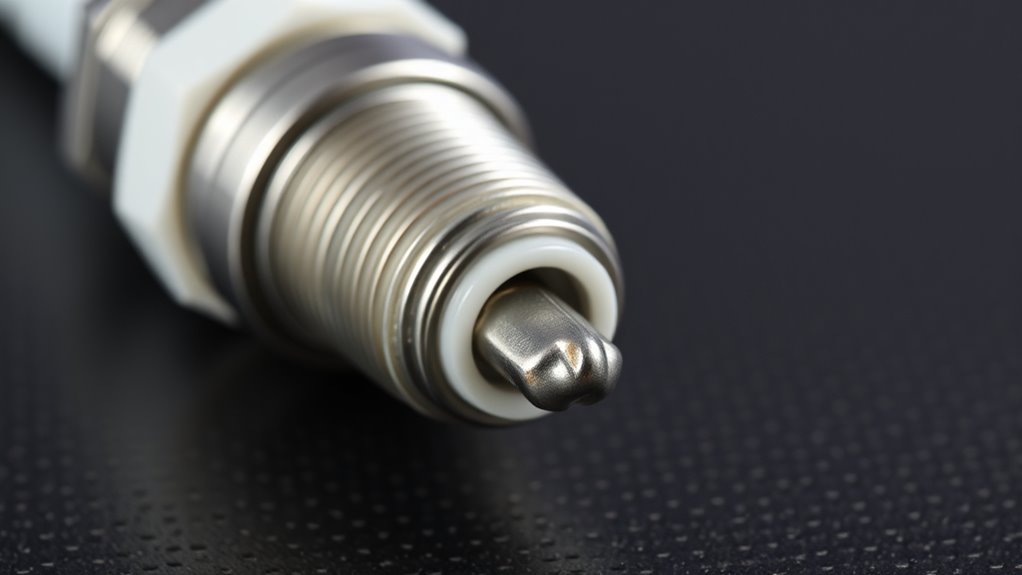
Analyzing spark plug data provides valuable insights into your engine’s health and performance. By examining the color, deposits, and electrode wear, you can identify specific problems. For example, a white or blistered insulator may indicate overheating, while wet or oily plugs suggest oil leaks or fuel issues. Spark plug fouling can point to incorrect fuel mixture or weak ignition. Regular inspection of spark plugs is a key component of emergency preparedness for maintaining vehicle reliability during unforeseen situations. Key indicators to watch for include:
- Color and deposit patterns: diagnose fuel mixture or combustion issues.
- Electrode wear: assess ignition system health.
- Insulator condition: detect overheating or misfire problems.
Understanding these signs helps you pinpoint issues early, preventing more serious damage and improving engine efficiency. Proper interpretation of spark plug data is essential for effective troubleshooting.
Tips for Cleaning and Maintaining Spark Plugs

Regularly cleaning and maintaining your spark plugs guarantees ideal engine performance and extends their lifespan. Start by inspecting your plugs for signs of wear, carbon buildup, or corrosion. If you notice deposits, gently scrub them off with a wire brush or a spark plug cleaner. Use a solvent like brake cleaner or compressed air to remove dirt and debris from the plug’s surface and threads. Always handle plugs carefully to avoid damaging the insulator. When reinstalling, ensure the spark plug gap is set correctly according to your vehicle’s specifications. Regular maintenance also involves checking for cracks or damage that may affect performance. Properly cleaning the spark plug’s electrode can improve electrical conductivity and overall function. Keeping your spark plugs clean and well-maintained ensures efficient combustion, better fuel economy, and smooth engine operation.
Implementing Findings Into Performance Optimization
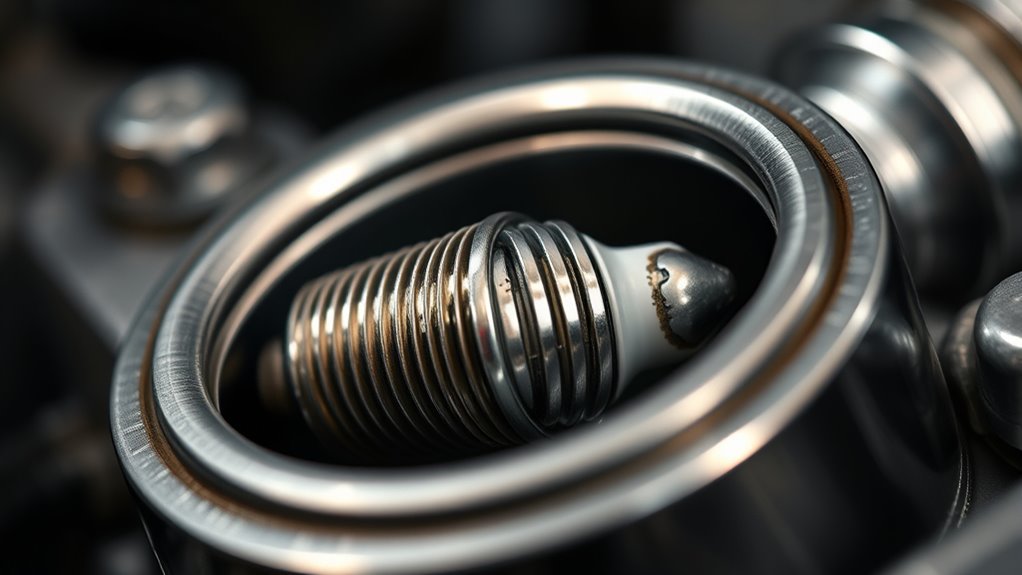
Cleaning and maintaining your spark plugs sets the foundation for peak engine performance, but to truly harness their potential, you need to implement these improvements into your vehicle’s operation. Start by adjusting your ignition timing and fuel mixture based on your spark plug readings. Fine-tuning these settings ensures ideal combustion and power output. Next, consider upgrading components like the air intake or exhaust system to complement your spark plug insights. Finally, monitor your vehicle’s response after each change, noting improvements or issues. To maximize results, focus on:
- Fine-tuning ignition timing and fuel mixture
- Upgrading supporting parts like intake/exhaust
- Continuously monitoring performance and making adjustments
Frequently Asked Questions
How Often Should I Replace Spark Plugs for Optimal Performance?
You should replace your spark plugs every 30,000 to 50,000 miles for maximum performance. Regular replacement guarantees your engine runs smoothly, improves fuel efficiency, and prevents misfires. If you notice rough idling, hard starts, or decreased acceleration, it’s a sign your spark plugs may need changing sooner. Always follow your vehicle’s manufacturer recommendations and inspect your plugs during regular maintenance to keep your engine running at its best.
Can Spark Plug Reading Help Diagnose Ignition System Problems?
Yes, reading your spark plugs can help diagnose ignition system problems. When you inspect them, look for signs like black soot, which indicates a rich fuel mixture, or white deposits, suggesting overheating. If you notice worn or damaged electrodes, it could point to issues with your ignition timing or spark strength. Regularly checking your spark plugs allows you to identify and fix ignition problems early, keeping your engine running smoothly.
What Spark Plug Types Are Best for High-Performance Engines?
You’re about to discover the secret to unlocking your engine’s full potential! For high-performance engines, you’ll want iridium or platinum spark plugs—they’re like rocket fuel for your car. These plugs offer superior durability, better ignition, and enhanced efficiency, making your engine run smoother and more powerful. Don’t settle for standard; upgrade to the best to truly unleash your engine’s capabilities and experience peak performance every time you hit the gas.
How Does Ambient Temperature Affect Spark Plug Coloration?
Ambient temperature influences spark plug coloration by affecting combustion efficiency. When temperatures are high, your engine runs hotter, leading to darker, sooty spark plugs due to incomplete combustion or oil deposits. Cooler environments promote cleaner, lighter-colored deposits, indicating ideal combustion. You should monitor plug color regularly, adjusting your tuning or cooling system if you notice abnormal coloration, ensuring your engine runs smoothly regardless of external temperatures.
Are There Specific Tools Recommended for Accurate Spark Plug Analysis?
You’ll want to use specific tools to analyze spark plugs accurately. A good spark plug socket with a rubber insert helps you remove and inspect plugs without damage. A flashlight or magnifying glass allows for detailed viewing of coloration and deposits. For precise analysis, consider using a spark plug colorimeter, which measures the hue objectively. These tools help you interpret plug condition correctly, ensuring ideal engine performance and tuning.
Conclusion
Just like Sherlock Holmes deciphering clues, reading your spark plugs reveals your engine’s true story. By understanding their signs, colors, and wear patterns, you can fine-tune your ride for peak performance. Keep a close eye on these tiny detectives—your engine’s silent witnesses—and use their clues to troubleshoot, clean, and optimize. Mastering this art transforms your car into a finely-tuned machine, ready to conquer the road like a detective solving a mystery.









